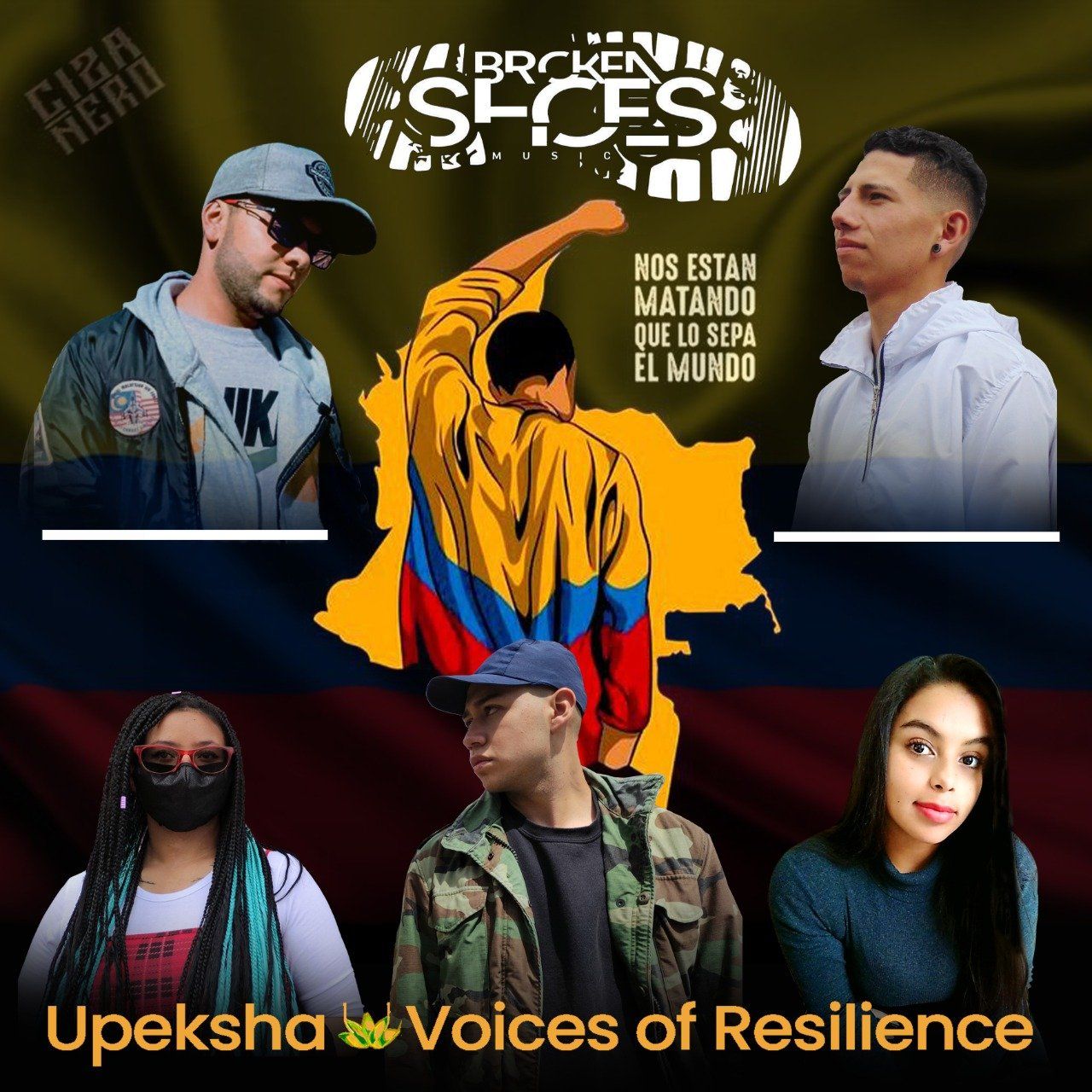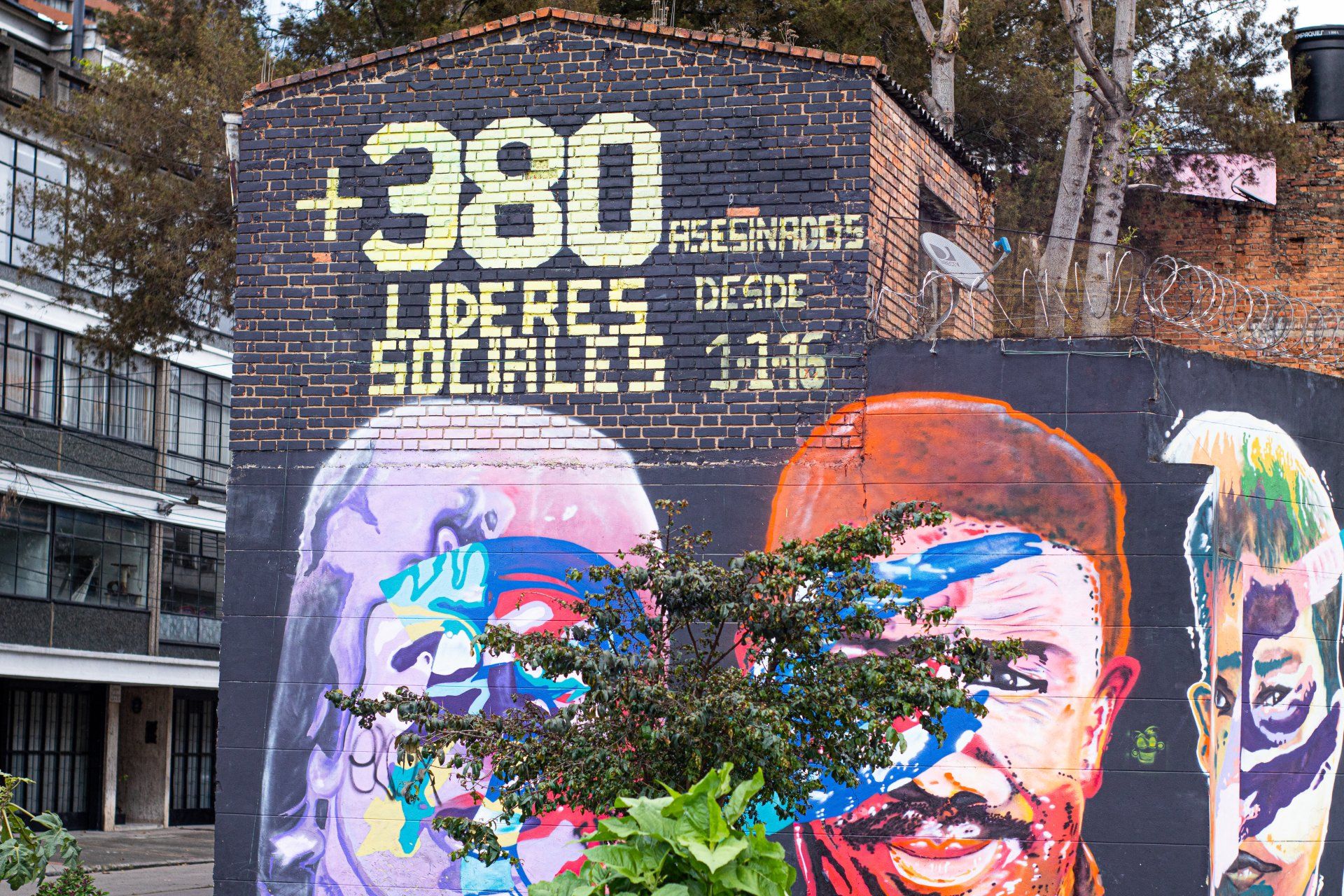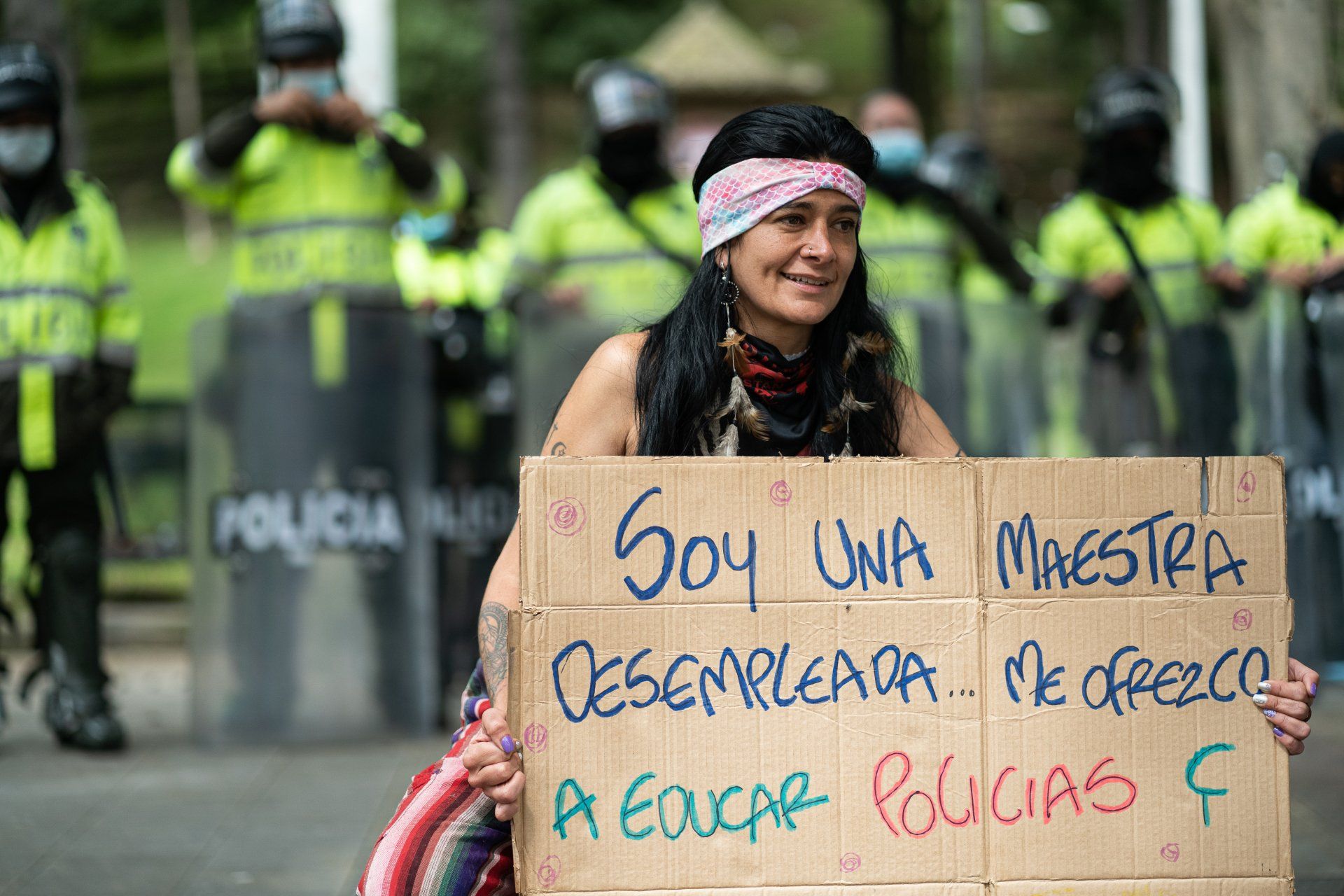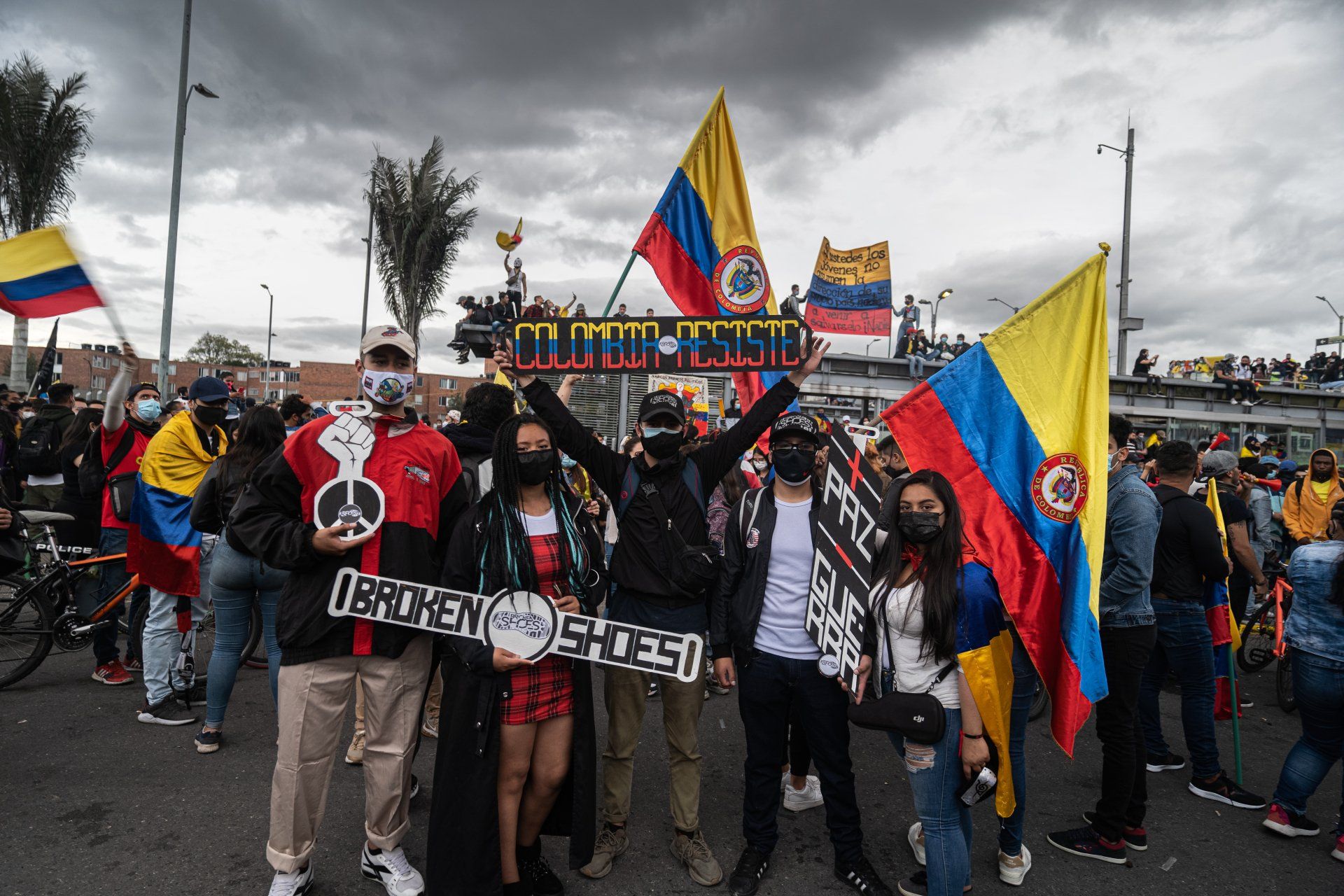About the demonstrations in Colombia in 2021
On April 28, 2021, thousands of Colombians took the streets in dozens of cities, villages and on the countryside. While protests against the government of president Ivan Duque have happened many times before and started way back in 2018, the demonstrations in the spring of 2021 turned out the be the biggest, longest and most repressed so far.
So why now? What happened on April 28 that ignited this massive uprising? Initially, the demonstrations were a response to a
tax reform that Ivan Duque proposed a few days earlier. To understand why this caused so much anger, we have to understand some context. After a year of Covid 19 measures, many Colombians are struggling to make ends meet. A large part of Colombia’s labor force is ‘informal’, meaning they sell food and goods on the streets, perform in public busses, clean houses, etc. This entails work without a contract and work for which they have to leave the house. As a consequence, the corona measures imposed, in particular the lockdown and the curfew, have been extra difficult for these people, as the government has not been able to cover any of their financial losses, causing increased poverty and famine. At some point, some Colombians waved a
red flag out of their windows as a symbol of the dangerous point poverty was reaching in Colombia. After all of this, President Duque decided to propose tax reforms that wouldn’t so much affect the rich, but mostly affect lower middle class and the poor; the ones who were also affected most by the pandemic. They proposed a lowering of the lower limit of the salary at which you’d have to pay income tax, a measure that would directly and exclusively affect the lower middle class (in Colombia those who have a job with minimum wage are considered lower middle class and those with informal jobs, no formal housing, etc. are consider lower class. This however is up to discussion, when we make the comparison to the living standards of many western countries. From this point of view, we may very well classify Colombia´s lower middle class as lower class). Secondly, the Colombian government planned to impose taxes on basic good such as milk and eggs, which were free of tax before. This measure effects everyone, however relatively it would make a much bigger difference to those with less financial means. Within the context of the suffering caused by the Covid 19 pandemic and the inability of the government to deal with that, this proposal caused national outrage. This only added to the government´s already long record of corruption, so people had no faith that this extra tax revenue would be spend responsibly. This was the action that caused the initial demonstrations on April 28, 2021. But as said before, the demonstrations against the government of Ivan Duque happened many times before for many different reasons, and soon the demonstrations became about much more than a single tax reform.
At the very first day, April 28, the government responded to the demonstrations with heavy repression. Especially in Cali, the demonstrations were met with extreme violence by the Colombian police forces, and only on that first day,
6 people were killed. And while in the past these killings may have caused enough fear in the people to stop demonstrating, this time it just put oil on the fire. People weren’t just demonstrating a tax reform anymore (which Duque withdrew about a week later), they were now fighting against police violence, police abuse, inequality, corruption, killings of social leaders, a proposed healthcare system reform, and a system of power that benefits a minority of rich people and companies at the cost of the rest. For instance, while
international corporations have benefited from Colombia’s peace treaty with the FARC in 2016, as well as additional deregulation policies of the Colombian government, more than
1100 social leaders have been killed. People that were defending their land and their rights, murdered in cold blood. So the demonstrations continued. Day in day out, people took the streets. And the repression only got worse. So far,
73 people have been killed and many more are missing. However, unlike many of those killed social leaders, these people were assassinated right under the eye of the public. At some point there were many videos circulating the internet of demonstrators getting shot and killed. The most viral was a video of a 36-year-old student named Lucas Villa Velásquez who was filmed dancing and singing all day long in his hometown Pereira only to be hit 8 times later that night by gun shots fired from an unknown vehicle. The violence against the demonstrators also seems to have come from civilians and paramilitaries who support the government, as they were photographed fully armed with machine guns and bulletproof vests on the streets siding with the police. Lucas initially survived the attack and was put in a coma. Because of the video’s many people around the world were confronted with the harsh repressions of peaceful demonstrators and even the rapper Residente of the famous Puerto Rican music group Calle 13 contacted his family to show support and denounce the violence. Unfortunately, Lucas didn’t make it. He passed away on May 11. But while the world was able to ignore the many killings of social leaders over the last few years, it couldn’t ignore these images, and international organizations like the United Nations and the International Court of Justice have denounced the repression of the Colombian government.
The government legitimizes its repression by saying they are protecting people and property from violent protestors. However, the repression didn’t just come with killings: 22 women have reported to be
sexually abused by policeman. One of them committed suicide afterwards. Can you also legitimize rape by saying it’s protecting people and property? Besides, 99% of the demonstrations have been peaceful, were attended by children and elderly, and have shown extreme creativity, with many artists using art as a nonviolent way of resistance. Unfortunately, the international media only picks up on these kinds of demonstrations when they become violent; a reason for some to use violent resistance tactics. And thus, there has been cases of violence by the hands of demonstrators. Most engaged in the throwing of rocks to the police, breaking busses and bus stations and the looting of stores. However, there have also been reports of the
sexual abuse of a policewomen by a group of demonstrators. There is no way rape can be legitimized as a righteous resistance tactic and we regret the suffering of this women as well as the murder of two police officers.
But because the media only covers the violent parts, to outsiders it seems like the demonstrations were mostly violent. However, the vast majority of people demonstrated peacefully, fighting hate and violence with love and creativity. But as we have seen with our own eyes, it has been peaceful protesters like Lucas that have been killed in cold blood and some of the dead were merely caught in the crossfire, when they walked past the police while not even being part of the demonstrations. But even those that did throw rocks didn’t deserve to die. As a matter of fact, according to the Colombian constitution it is illegal for the police to kill those people, as the legal way of prosecuting would have been though court.
We ask the world to do more than just denounce the violence. Governments and agencies around the world have to take responsibility for their own role in what is happening in Colombia. Because most western countries explicitly support the administration of Ivan Duque, both politically and financially, and many western companies benefit from his policies (and some even directly engaged in the killing of social leaders through the
financing of paramilitaries). We turn to all political leaders and businessman and ask them this: if you really do denounce violence and injustice, do something about it, even if that violence benefits you financially.
Below you can find a list of the victims of the demonstrations.
We will never forget them.
We will always remember.
List of Victims by homicide during the demonstrations in Colombia until 31st of may 2021
Data by Indepaz












